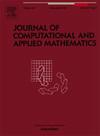New error estimates for the conjugate gradient method
IF 2.1
2区 数学
Q1 MATHEMATICS, APPLIED
Journal of Computational and Applied Mathematics
Pub Date : 2024-11-12
DOI:10.1016/j.cam.2024.116357
引用次数: 0
Abstract
The conjugate gradient method is the default iterative method for the solution of linear systems of equations with a large symmetric positive definite matrix . The development of techniques for estimating the norm of the error in iterates computed by this method has received considerable attention. Available methods for bracketing the -norm of the error evaluate pairs of Gauss and Gauss–Radau quadrature rules to determine lower and upper bounds. The latter rule requires a user to allocate a node (the Radau node) between the origin and the smallest eigenvalue of the system matrix. The determination of such a node generally demands further computations to estimate the location of the smallest eigenvalue; see, e.g., Golub and Meurant (1997), Golub and Meurant (2010), Golub and Strakoš (1994), Meurant (1997), Meurant (1999). An approach that avoids the need to know a lower bound for the smallest eigenvalue is to replace the Gauss–Radau quadrature rule by an anti-Gauss rule as described by Calvetti et al. (2000). However, this approach may sometimes yield inaccurate error norm estimates. This paper proposes the use of pairs of Gauss and associated optimal averaged Gauss quadrature rules to estimate the -norm of the error in iterates determined by the conjugate gradient method.
共轭梯度法的新误差估计
共轭梯度法是求解具有大型对称正定矩阵 A 的线性方程组的默认迭代法。用这种方法计算的迭代中误差规范的估算技术的发展受到了广泛关注。现有的括弧误差 A 准则方法会评估一对高斯和高斯-拉道正交规则,以确定下限和上限。后一种规则要求用户在原点和系统矩阵最小特征值之间分配一个节点(拉道节点)。确定这样一个节点通常需要进一步计算,以估计最小特征值的位置;参见 Golub 和 Meurant (1997)、Golub 和 Meurant (2010)、Golub 和 Strakoš (1994)、Meurant (1997)、Meurant (1999)。一种无需知道最小特征值下限的方法是用 Calvetti 等人(2000 年)所述的反高斯规则取代高斯-拉道正交规则。然而,这种方法有时会产生不准确的误差规范估计值。本文提出使用成对的高斯和相关最优平均高斯正交规则来估计共轭梯度法确定的迭代中误差的 A 准则。
本文章由计算机程序翻译,如有差异,请以英文原文为准。
求助全文
约1分钟内获得全文
求助全文
来源期刊
CiteScore
5.40
自引率
4.20%
发文量
437
审稿时长
3.0 months
期刊介绍:
The Journal of Computational and Applied Mathematics publishes original papers of high scientific value in all areas of computational and applied mathematics. The main interest of the Journal is in papers that describe and analyze new computational techniques for solving scientific or engineering problems. Also the improved analysis, including the effectiveness and applicability, of existing methods and algorithms is of importance. The computational efficiency (e.g. the convergence, stability, accuracy, ...) should be proved and illustrated by nontrivial numerical examples. Papers describing only variants of existing methods, without adding significant new computational properties are not of interest.
The audience consists of: applied mathematicians, numerical analysts, computational scientists and engineers.

 求助内容:
求助内容: 应助结果提醒方式:
应助结果提醒方式:


